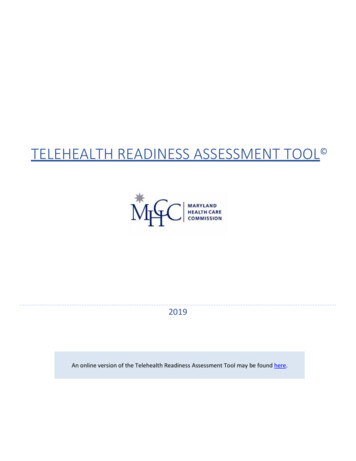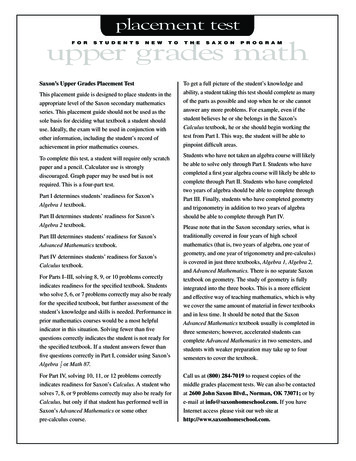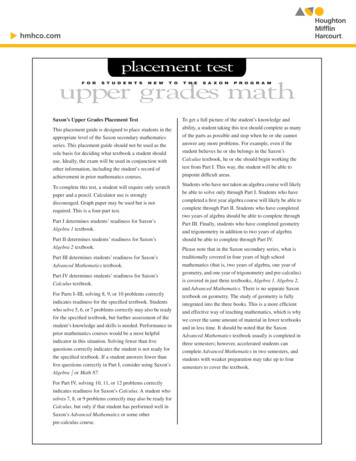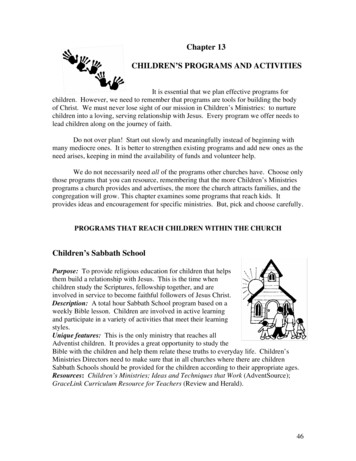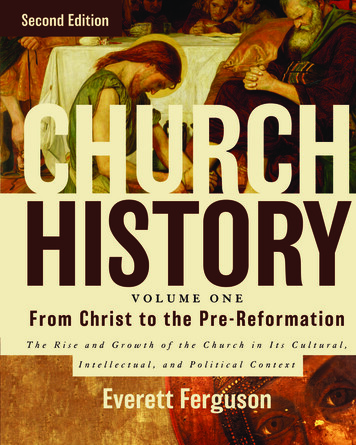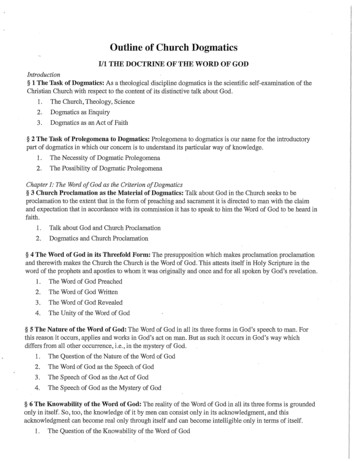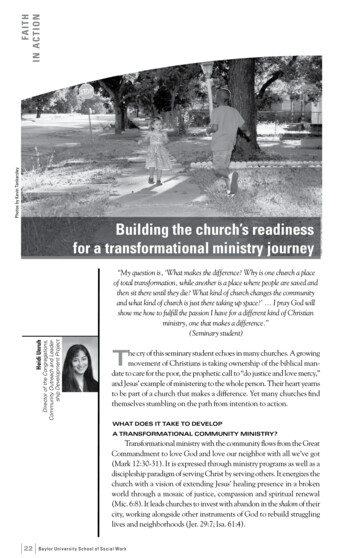
Transcription
Fa i t hin ac t io nPhotos by Kevin TankersleyBuilding the church’s readinessfor a transformational ministry journeyHeidi UnruhDirector of the Congregations,Community Outreach and Leadership Development Project“My question is, ‘What makes the difference? Why is one church a placeof total transformation, while another is a place where people are saved andthen sit there until they die? What kind of church changes the communityand what kind of church is just there taking up space?’ . I pray God willshow me how to fulfill the passion I have for a different kind of Christianministry, one that makes a difference.”(Seminary student)The cry of this seminary student echoes in many churches. A growingmovement of Christians is taking ownership of the biblical mandate to care for the poor, the prophetic call to “do justice and love mercy,”and Jesus’ example of ministering to the whole person. Their heart yearnsto be part of a church that makes a difference. Yet many churches findthemselves stumbling on the path from intention to action.WHAT DOES IT TAKE TO DEVELOPA TRANSFORMATIONAL COMMUNITY MINISTRY?Transformational ministry with the community flows from the GreatCommandment to love God and love our neighbor with all we’ve got(Mark 12:30-31). It is expressed through ministry programs as well as adiscipleship paradigm of serving Christ by serving others. It energizes thechurch with a vision of extending Jesus’ healing presence in a brokenworld through a mosaic of justice, compassion and spiritual renewal(Mic. 6:8). It leads churches to invest with abandon in the shalom of theircity, working alongside other instruments of God to rebuild strugglinglives and neighborhoods (Jer. 29:7; Isa. 61:4).22Bay lor Uni ver si t y School o f Social Wor k
BUILDING READINESSWhat kind of church canWhat does it take for a churchFORA TRANSFORdevelop transformational ty ministry? Is this kindchange,despitetheobstacles?JOURNEYof ministry more likely to takeBecoming a church thatResearch suggests seven criticalroot in a growing church, an izaban church, a liberal church, acommunityministry is ation:young church?journey–hazardous,windStudies have identified a healthy foundationing, and richly rewarding.various factors such as size, class, a compelling visionWhat does it take for atheological tradition, and loca a plan for actionchurch to make it throughtion that correlate with social missional resourcesthe process of change,service activity.1 But none of a motivational catalystdespite the obstacles? Rethese fully satisfies the semi change-sustainingsearch suggests seven critinarian’s desire to know “whatrelationshipscal components for churchmakes the difference” between transformational leadershipmobilization: a healthychurches that place missionskillsfoundation; a compellingat the heart of their existencevision; a plan for action;and those that are motivatedmissional resources; a moprimarily by self-maintenance. After ionthe relationship between community ministryships; and transformational leadership skills.4and salient variables, Ram Cnaan concludes:Note that these components are not how-toGiven that most congregations are involvedstepsto developing community ministry. Theyin at least one social service program, theare,rather,characteristics of a church that isdistinction between the high performersready to take effective steps toward developingand the low performers is not mediatedcommunity ministry. They describe elementalby budget, size, membership, or theology.qualities of churches that live out Christ’s goodRather, it is mediated by the congregation’snews in word and deed in their community. Acommitment to faith-based action and a trachurch that has these qualities is more likely todition of congregational care.2succeed in carrying out the changes needed toBased on a study of how churches learn totruly make a difference.3do ministry, we conclude that moving a churchLacking one or more of these readiness facinto transformational community ministry oftentors, a church may experience more difficultiesentails more than comprehending new ideas oron the path toward transformational ministry.implementing new projects. It calls for becomingIf a church has all the pieces in place except aa new kind of church. A missional church seesplan for action, the momentum toward changeitself as a “sent” church (Matthew 28:19), onemay produce reports and committees but no truethat exists not just for itself but also for the sakereal-world traction. Without sufficient resources,of a beloved, broken world. As this paradigma church is likely to experience frustration as itseeps into a church’s DNA, it changes how astarts ministry projects it lacks the capacity tocongregation sets its priorities, communicatescomplete. A church that does not have a sense ofits identity, allocates its resources, and definesurgency for change may still move toward comsuccess.munity ministry, but only gradually. If a churchSharing in God’s transforming mission inlacks leadership skills, the change process maythe community goes hand in hand with transgenerate overwhelming anxiety and conflict.formation within the church. Thus developingFollowing the metaphor of a journey, eacheffective ministry typically means venturingreadinessfactor corresponds to a metaphor forthrough change. And change is never easy.travel:F amil y and C ommuni t y Minis t r ies23
1. ROAD: The journey toward transforma-through next year, or even next week. But unless the goal of movement is intentional and actional community ministry must be launched oncountable, it is most likely the church will nota sufficient foundation of church health. Thismove.includes mature leadership, relational health,How to strengthen this readiness factor: Train aand spiritual vitality. A church that is strugcommunity ministry team empowered to developgling with bitter internal divisions or a pastoralan action plan for the next steps of communitycrisis is not in a position to initiate a new minisoutreach, and to work with church leaders totry. Another foundational element is a generalimplement it.theological compatibility with a sense of callingto external ministry – or at least, a theological4. FUEL: The journey toward transformaframework that is not opposed to outreach oftional mission requires resources of “time, talword and deed.ent, and treasures.” Assets can include money,How to strengthen this readiness factor: Assessfacilities, equipment, and people, as well asyour church’s relational, spiritualintangible strengths such as skills,and organizational health; workconnections, and reputation. Astoward healing wholeness amongsets should be recruited for ministry from both the church and themembers, and build up the churchcommunity. The magnitude of thethrough intentional opportunitiesA catalyst for changeresources is not as important asfor mission-oriented discipleship.2. DIRECTION: Eric Swansonwhether there is a plan in place forpropels a churchnotes, “City transformation (likeidentifying and mobilizing them foroutofitsnormalpersonal conformity to Christ) iscommunity ministry.more like the North Star (a direcHow to strengthen this readinessroutine and generatestion to pursue) than the North Polefactor: Conduct an asset inventorymissional momemtum.(a destination we can arrive at).” 5in the church and community; 6Change is guided by a compellingseek training in fundraising andvision or portrait of a preferred fuvolunteer mobilization.ture for the church and communi5. STARTER: A church mayty, worth exchanging people’s timebe drawn toward the ministry jourand energy to help bring about. Hunger for God’sney, but needs a larger-than-life motivation tokingdom and God’s righteousness is the compasshit the start button. A catalyst for change propelsthat points toward transformational ministry.a church out of its normal routine and generHow to strengthen this readiness factor: Studyates missional momentum. A catalytic sense ofScriptures and other sources that lay out a bibliurgency can come from many sources: a spiritualcal vision for the local mission of the church;awakening, a newfound biblical conviction, agather for ongoing prayer to discern God’s direcpowerful short-term ministry experience, a crition for your church.sis in the neighborhood or the nation. The spur3. ROAD MAP: Churches need a strategicto change may also be less altruistic – such as aplan to move from vision to action. This doeswake-up call that the church’s decline can onlynot necessarily mean a detailed strategy for thebe reversed by revitalizing its relationship withnext 10 years of ministry. Rather, what is neededthe community.is an intentional plan for taking the next step,How to strengthen this readiness factor: Createand then the next. Putting feet to faith entailsopportunities for church members to share cata basic framework of accountable action stepsalytic ministry experiences, such as short-termfor discerning ministry opportunity, mobilizingministry projects or exposures to poverty. 7people and resources to respond, and growing6. ENGINE: Relationships are the drivingthrough reflection and relationship. The nextforce behind transformational ministry. Misleg of the road map may only take your churchsional change is guided and sustained through24Bay lor Uni ver si t y School o f Social Wor k
redemptive relationships with the community,within the church, and with ministry partners.The core of transformational ministry is love forGod and neighbor (Mark 12:30–31). A churchcan best prepare for a ministry journey by cultivating loving, accountable fellowship withinthe congregation, an authentic, servant-heartedconnection with the community, mission-oriented links with the broaderbody of Christ, and a deeppassion for God.How to strengthenthis readiness factor: Oneof the first and most important ways to show loveto a neighbor is by simplylistening to their concernsand dreams, while openingour lives to them. Createopportunities for churchmembers to develop relationships with membersof the community (someideas: block parties, family game nights, community garden, neighborhood newsletter, “diningclubs” in local restaurants, community clean-updays).7. DRIVER: Churches need a core leadership team with the skills, vision and support tonavigate the transformational ministry journey.The transition from faith to action is smootherif piloted by the pastor or official governing bodyof the church; at minimum, if not on board, theyneed to be out of the way. But other ministrymidwives can also emerge: mission staff, ministrycommittees, Bible study groups, vision teams.Leaders assess the congregation’s readiness forministry in relation to the first six readiness factors described above. They take responsibilityfor developing internal conditions and externalconnections to help the church creatively andcollectively put their faith into action. They maynot know how to do this exactly – but they areeager and empowered to learn.How to strengthen this readiness factor: Offer leaders training in a missional paradigm andtransformational leadership skills; 8 identify andequip lay members who display vision and giftsfor ministry leadership.GETTING STARTED ON THE JOURNEYThese seven factors describe a church thatis ready to roll, motivated to move, pointed inthe right direction, with empowered leadershipat the helm. But it still takes a spark to ignitethe motor. The spark of the church is the HolySpirit. The conduit for the Spirit’s work in ourministry is persistent prayer. Without prayerfuldependence on God’s love and power, none ofthese seven elements is sufficient to produce achurch that truly makes a difference. Only thetransforming grace of God can drive us beyondour stubborn resistance, prideful self-reliance,faithless fears, and self-centered comfort.The good news is that it is God’s design tosupply the church with all that it needs for ministry (1 Corinthians 12:7, Ephesians 2:10, 1 Peter4:10). The test of readiness for transformationalministry is not what a church has, but how it iswilling to use what it has.Even if a church lacks a detailed understanding of what it means to be a missionalcongregation, it can still decide that it needsto become one. Even if a church doesn’t knowexactly where it is headed, it can take the nextstep toward serving the community in love.Even if church leaders make mistakes along theway, they can choose to learn and grow fromF amil y and C ommuni t y Minis t r ies25
each ministry experience. Even if only limitedpeople and resources are available for ministry,the church can invest what assets it finds in thechurch and community, in faith that God willprovide for each stage of the journey.Ministry development is an incrementalprocess. There are no “transporters” to vault us toour goal. Each small step toward reflecting God’skingdom “on earth as it is in heaven” (Matthew6:10) creates the opportunity to plant relationships, generate learnings and create momentumfor the next step and the next. If you hunger for change in your church and community,don’t focus your energies on cataloguing thechurch’s deficiencies. Rather, look for signpostsof opportunities to share God’s love, particularlywith those cast off on “the streets and alleys” oflife (Luke 14:21). Then ask the question, “Whois willing to go there with me?” Start with thosewho say yes, and see where this leads your churchand community.ENDNOTES1. David Roozen and Carl Dudley, FaithCommunities Today: a Report on Religion in theUnited States Today. Report from the Faith Communities Today (FACT) Study (2001); JasonScott, The Scope and Scale of Faith-Based SocialServices (Albany, NY: The Roundtable on Religion and Social Welfare Policy, 2002).2. Ram A. Cnaan, Stephanie C. Boddie,and Gaynor I. Yancey, “Bowling Alone but Serving Together: The Congregational Norm ofCommunity Involvement,” in Religion as SocialCapital, ed. Corwin Smidt (Waco, TX: BaylorUniversity Press, 2003), 114-115.3. Heidi Rolland Unruh, “Learning AboutHow Churches Learn About Social Ministry:Reflections on Research that Explains and Empowers,” research report to the Lilly Endowment(September 2004).4. This analysis incorporates material fromStan Rowland, “Church Initiated NeighborhoodTransformation,” a PowerPoint available fromthe Collaborative For Neighborhood Transformation, http://www.healthwholeness.net/index.php.26Bay lor Uni ver si t y School o f Social Wor k5. Eric Swanson, “To Transform a City”(January 2, 2007).6. Jay Van Groningen, “Learning the NewABCDs,” in Family and Community Ministries,v. 22, no. 1 (Spring 2008), 37-40.7. Three good resources for getting started:Faith in Action, www.putyourfaithinaction.org;Harvest’s seed project guide, www.harvestfoundation.org; Mission Waco’s exposure trips andpoverty simulation, www.missionwaco.org.8. Three useful books for transformationalleaders in training: Jim Herrington, The Leader’s Journey: Accepting the Call to Personal andCongregational Transformation (San Francisco:Jossey-Bass, 1997); Milfred Minatrea, Shaped byGod’s Heart: The Passion and Practices of MissionalChurches (San Francisco: Jossey-Bass, 2004);Alan J. Roxburgh & Fred Romanuk, The Missional Leader: Equipping Your Church to Reacha Changing World (San Francisco: Jossey-Bass,2006).REFLECTION QUESTIONS:ww What are your church’s greatest strengthsfor a transformational ministry journey (readiness factors already or mostly in place)?ww What are your church’s greatest priorities in growing toward transformational ministry(readiness factors to be developed)?ww What are one to three action steps (including prayer) that can be taken in the nearfuture to strengthen your readiness for transformational community ministry?
A TRANSFORMATIONAL COMMUNITY MINISTRY? Transformational ministry with the community flows from the Great Commandment to love God and love our neighbor with all we’ve got (Mark 12:30-31). It is expressed through ministry programs as well as a discipleship parad
